
Natural and Cultural Resources
- Plants and flowers
-
Red Rock Canyon has more than 600 different species of plants. Of those, 15 can only be found in Red Rock Canyon; they are found nowhere else in the world.
A few of our more common wildflowers and plants are listed below and can be found around the visitor center. Please keep in mind that you should take only photos of plants in Red Rock Canyon, leave the flowers and plants for others to enjoy.
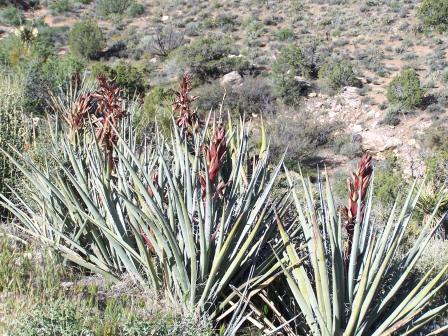 Banana Yucca (Yucca baccata)
Banana Yucca (Yucca baccata)- Native Americans used all parts of the plant for food, drink and everyday items.
- The baked fruit of this plant tastes somewhat like sweet potato.
- The root was pounded and soaked in water and used as shampoo.
- Navajos used the seeds to dye yarn.
- The Pronuba (Yucca) Moth is the only pollinator of the Yucca.
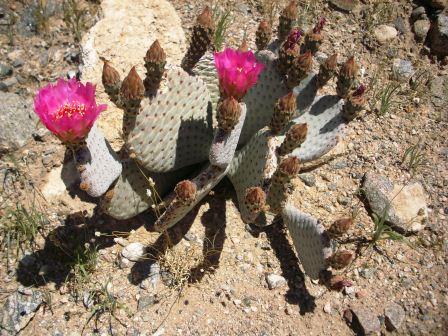 Beavertail cactus (Opuntia basilaris)
Beavertail cactus (Opuntia basilaris)- Grows six to 12 inches high and up to six feet wide.
- The cactus pads resemble a beaver’s tail.
- Fruits and pads of the cactus were eaten by Native Americans.
- The pads are also cooked and eaten as a vegetable.
- Sold in stores under the name “Nopalito.”
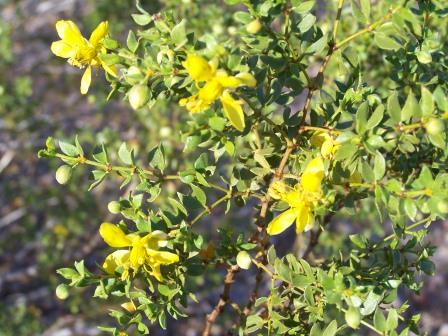 Creosote Bush (Larrea tridentata)
Creosote Bush (Larrea tridentata)- Can grow up to 12 feet tall.
- The plant goes dormant in summer and the leaves turn brown.
- Yellow pedals bloom from February to August.
- The leaves are coated with a waxy resin to prevent water loss.
- Has a unique odor after a desert rain.
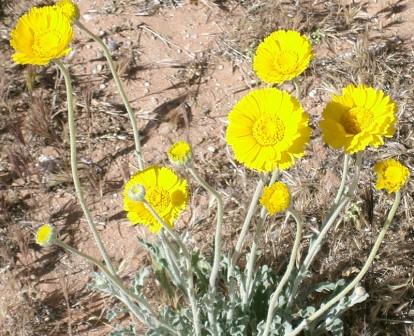 Desert Marigold (Baileya multiradiata)
Desert Marigold (Baileya multiradiata)- This plant ranges in elevation from 100 to 6,500 feet.
- It is a drought tolerant plant.
- They begin to flower in March and can continue to bloom until November.
- Often seen growing along roadsides.
- This plant is poisonous to goats and sheep.
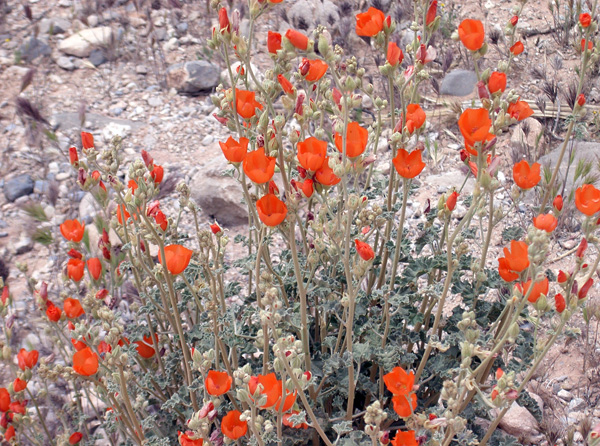 Globemallow (Sphaeralcea ambigua)
Globemallow (Sphaeralcea ambigua)- Main food staple for the Desert Tortoise.
- Leaf hairs are an eye irritant to some people.
- Used by Native Americans for medicinal purposes.
- Attracts hummingbirds and butterflies.
- Is grazed upon by bighorn sheep.
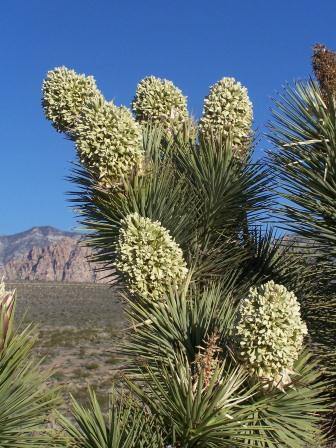 Joshua Tree (Yucca brevifolia)
Joshua Tree (Yucca brevifolia)- Named by Mormon settlers for the biblical Joshua reaching his hands up to the sky to pray.
- May start blooming in mid-March.
- The tree was used for fuel in steam engines.
- Has been known to live up to 1,000 years.
- At maturity can reach a height of 30 feet.
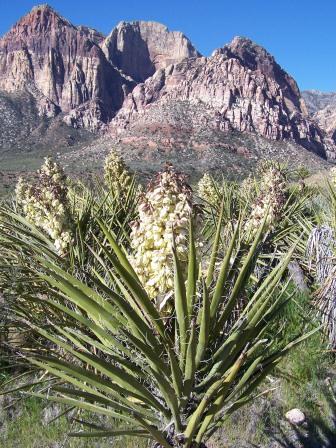 Mojave Yucca (Yucca schidigera)
Mojave Yucca (Yucca schidigera)- Known as Spanish Dagger.
- Grows to a height of 16 feet.
- Plant depends on the Pronuba (Yucca) Moth for pollination.
- Fibers of the leaves were used by Native Americans for rope and sandals.
- Roots were used to make soap.
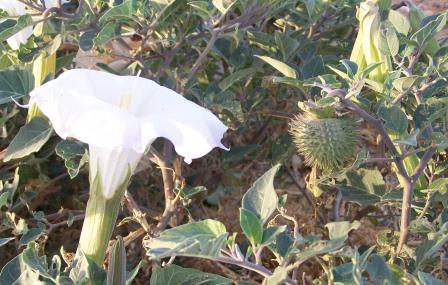 Sacred Datura (Datura wrightii)
Sacred Datura (Datura wrightii)- Also called Jimson weed.
- It is a member of the Nightshade family (Solanaceae).
- All parts of this plant are toxic.
- The large white flower of the plant opens up in the evening.
- This allows it to attract the night-flying sphinx moth.
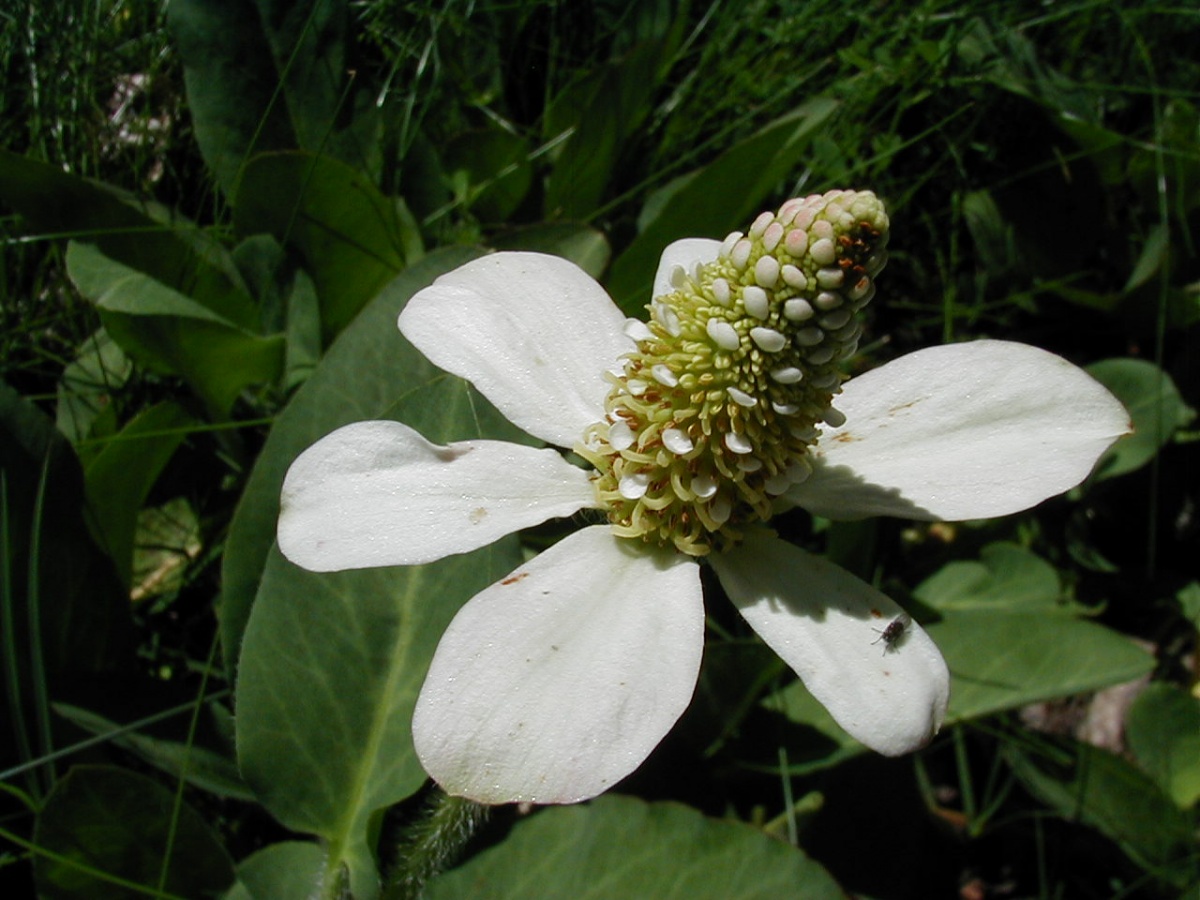 Yerba Mansa (Anemopsis californica)
Yerba Mansa (Anemopsis californica)- Native to southwestern North America.
- A perennial flowering plant.
- Yerba Mansa means “calming herb” in Spanish.
- Used by herbalists as a poultice to reduce inflammation.
- Also used as a diuretic to assist with joint problems
Red Rock Canyon National Conservation Area supports a wide variety of plant species due to soil types and depth, elevation, exposure, temperature, precipitation, and existing and past use.
Located in the Mojave Desert, Red Rock Canyon supports nine major vegetation types:
Pinyon-Juniper
This vegetation type lies between 5,000 and 7,000 feet and receives between 10 to 18 inches of precipitation a year. It forms a belt between the desert below and the true forest above. The lower edge of the belt is occupied by juniper; but at higher elevations pinyon pine and juniper intermix. At the upper edge of the belt, pinyon pine becomes prevalent. Curl-leaf mountain mahogany, big sagebrush and blackbrush are also found in this vegetation type in varying amounts. Three awn, Nevada bluegrass and cheatgrass make up the majority of the grass species present.Joshua Tree
This vegetation type is found between 3,600 and 4,200 feet and receives between 8 and 10 inches of precipitation annually. Joshua tree is the dominant species in this type and makes up three to 10 percent of the total species composition. Blackbrush, creosote bush, Mormon Tea and burrobrush also make up portions of this type. Grasses are usually sparse and species are mostly annuals.Rabbitbrush
This vegetation type can range between 3,400 and 9,000 feet elevation, but in this area it is found between 3,400 and 4,200 feet. Annual precipitation usually is low, ranging from six to eight inches. Rabbitbrush is generally found on eroded or disturbed soils along roadsides and in wash bottoms. It characterizes a soil with a relatively low alkali content.Oak Brush
This vegetation type generally occurs from 4,000 to 6,000 feet in Red Rock Canyon. Precipitation is usually between eight and 10 inches. Sagebrush, manzanita, snowberry and rabbitbrush are some of the scrub species that also occur in this type in varying amounts. Nevada bluegrass, Indian rice grass and big galleta, as well as several annual grasses and forbs also occur in this type.Blackbrush
This vegetation type is usually found from 4,000 to 6,000 feet elevation. This type is usually found in association with creosote, hopsage, sagebrush and wolfberry. Precipitation is fairly low - five to eight inches per year.Mantanita
This vegetation type is found in the area surrounding the escarpment in the rocky canyons and on the walls. Vegetation is found only on areas where soil has accumulated. The most limiting factor in this area is availability of soil. Precipitation usually ranges from eight to 10 inches annually. Other species in this vegetation type present in varying amounts are turbinella oak, cliffrose, desert barberry, desert ceanothus, snowberry, apache plume, juniper and pinyon pine. Various annual grasses and forbs also occur.Desert Shrub
This vegetation type is found generally to the east of the sandstone escarpment. Precipitation ranges from five to eight inches annually. Species found in this community consist of Spanish bayonet, blackbrush, Mormon tea, Cheesebush, Spiny Menodora, Desert Almond, Sagebrush, Bursage, cholla cactus, dalea, turpentine bush and catclaw. Grasses commonly found include needle grass, sand dropseed and big galleta grass. The wide variety of small flowering plants include buckwheats, marigolds, mallows and desert poppy. Several species of grasses also occur in moist years.Barren
This vegetation type is found on the eastern edge of the area and is mostly bare rock. Vegetative cover is found only in areas where soils accumulate and where water periodically stands, allowing seed germination. The main species are pinyon pine, juniper, manzanita, sagebrush, snakeweed and creosote. Sparse perennial grasses occur along with some annual grasses and forbs.Unique Vegetation
This type is limited mainly to the deep, cool, well-watered canyons of the escarpment. These canyons, especially Pine Creek, Oak Creek and First Creek, provide a microclimate which supports small communities of ponderosa pine and several other species not commonly found at this low elevation. Some of these other species are willow, serviceberry, snowberry, manzanita, sagebrush, black cottonwood and Gambel's oak. Nevada bluegrass, Indian ricegrass, blue grama and big galleta make up some of the grass species found there.The average age of ponderosa pines in these areas is 180 years. Reproduction is marginal. The trees are mostly concentrated in and along the creek bottoms. They may represent a relic population that was once part of a large pine forest, with these trees surviving in small pockets long after the rest of the forest disappeared.
In the past 40 years, many unique plants in the area have been subjected to heavy collection pressure. The sword fern, probably the most collected plant, has been reduced from large beds and glades to only occasional plants by trampling and collection.
Other unique plants in the area include Agave (Agave utahensis nevadensis), a conspicuous part of the cliff community in the Spring Mountains and Charleston mountain prickly pear cactus (Opuntia charlastonensis) which occurs only in the higher elevation, wooded areas of the Spring Mountains.
Riparian vegetation is associated with springs, creeks and dry washes. Plants more typical of the riparian type include mesquite, catclaw acacia, salt cedar and desert willow. In moister areas or along stream banks, cattails, rushes, willows and other semi-aquatic plants can be found.
- Wild horses and burros
-
BLM protects and manages wild horses and burros under the authority of the Wild Free-Roaming Horses and Burros Act of 1971 to ensure that healthy herds thrive on healthy rangelands.
The 220,000-acre Red Rock Herd Management Area is located in southern Nevada, approximately 20 miles west of Las Vegas. The Herd Management Area contains both wild horses and burros that represent living symbols of the Western spirit.
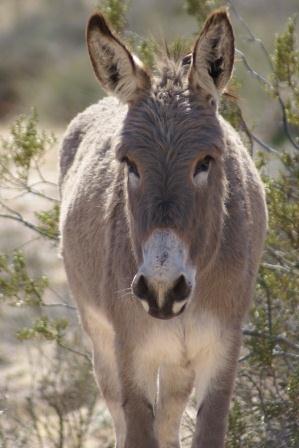 It’s often easier for visitors to see the burros in Red Rock Canyon National Conservation Area because they often congregate near Bonnie Springs, Spring Mountain Ranch and the town of Blue Diamond along State Route 159.
It’s often easier for visitors to see the burros in Red Rock Canyon National Conservation Area because they often congregate near Bonnie Springs, Spring Mountain Ranch and the town of Blue Diamond along State Route 159. Burros are well adapted to the Mojave Desert and survive high temperatures and long periods of time without green forage by using shade under rocky cliffs and shrubs and by being most active in the early morning and late afternoon. They survive the apparent lack of water by seeking out the natural springs and hidden waterholes found throughout Red Rock Canyon. They eat grasses and shrubs. Burros are generally less than half the size of a horse. Males are called jacks and females are called jennies.
Each year people are injured by burros as they try to feed or pet these animals. Feeding burros also causes them to lose their natural fear of roads and cars. Every year both burros and humans die from burro and automobile collisions due to this adaptation.
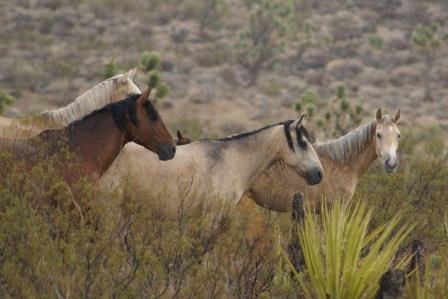 Wild horses may be seen at the extreme northern end of Red Rock neat Cold Creek. They also may be spotted at the extreme southern end of Red Rock on the dirt road leading from State Route 160 to Goodsprings.
Wild horses may be seen at the extreme northern end of Red Rock neat Cold Creek. They also may be spotted at the extreme southern end of Red Rock on the dirt road leading from State Route 160 to Goodsprings.To observe these beautiful animals safely:
- Pick a safe place to stop and pull completely off the roadway.
- Observe the burros from a distance.
- The safest place is from your car.
- Do not stand close to them, or get on their backs.
- Refrain from the temptation to feed or water these hardy desert creatures.
- If you have food in an open container, seal it if a burro approaches you.
- Drive carefully and be cautious when you see animals on or near the road. Burros may step out in front of your car unexpectedly.
For more information about BLM's wild horse and burro program, please click here.
- Birds
-
Red Rock Canyon National Conservation Area is an oasis in the desert. Its deep sandstone canyons provide a perennial water supply, cool temperatures and a wide variety of vegetation which serves as ideal habitat for many birds species. In fact, more than 100 bird species have been identified within Red Rock Canyon.
Many birds exhibit specific behavioral traits which allow them to survive in arid lands.
Eagles and hawks conserve water by soaring in high altitude air currents where strong winds allow them to stay aloft with little exertion and temperatures can be 20 degrees cooler than at ground level. Obtaining water is no problem for these birds; their water needs are satisfied by eating the moisture-rich flesh of small animals. The dark silhouettes of the red-tailed hawk, Cooper's hawk, golden eagle and other raptors can be seen against the blue sky.
Some birds have learned to use desert plants, especially those of the cactus family, for protection of captured prey.
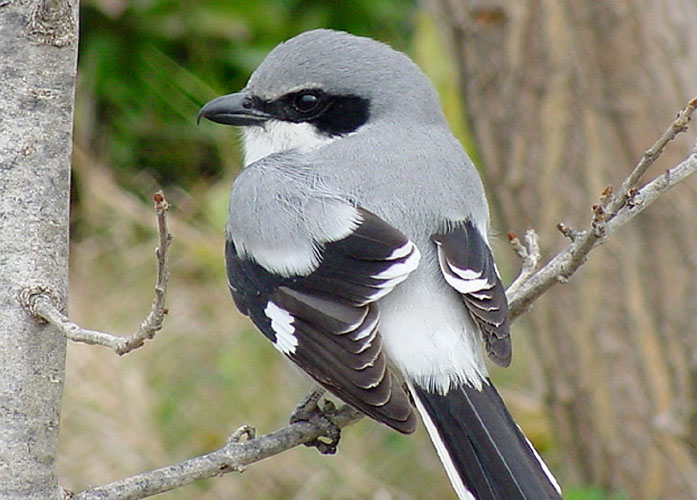
Loggerhead Shrike The loggerhead shrike, though a predatory bird, has weak feet and is unable to hold struggling prey in its grasp. To immobilize prey, the shrike will often impale it on cactus spines. It will eat the prey immediately or allow it to sun dry for later consumption.
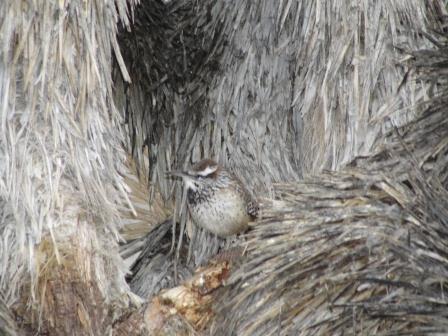
Cactus Wren The cactus wren, identified by its down turned bill, heavily streaked body and fan shaped tail, uses the spiny branches of the cholla cactus to protect its nests. The nests, which resemble a football, are built from desert plant stems and flower stalks. Up to 10 nests may be built by one pair of cactus wrens, but only one will be used to raise young. The unoccupied nests may serve to confuse and frustrate predators not hampered by cholla spines. The cactus wren does not wander far from its nests, rather it hunts succulent spiders, insects and larvae in the nearby vicinity.
A few birds have not only adapted behaviorally, but also have special body modifications to meet the demands of desert life.
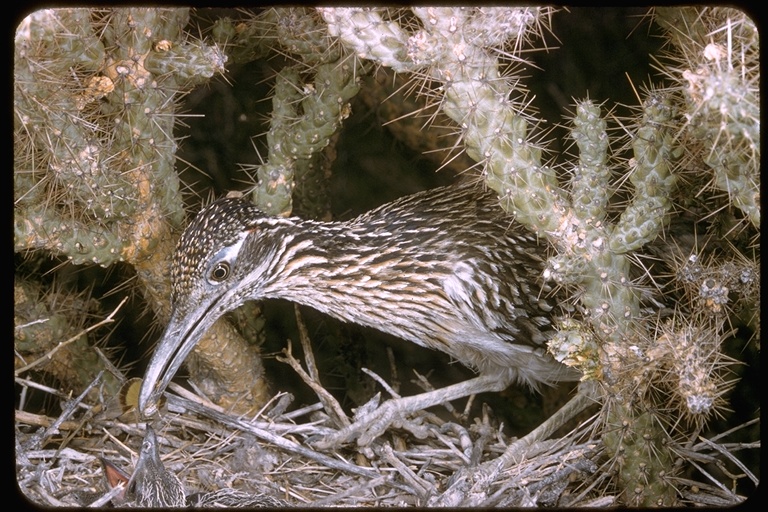
Roadrunner One such bird is the roadrunner. This desert member of the cuckoo family is a large bird about the size of a chicken. It is heavily streaked, has a bristle tipped crest and a long tail. It is most easily identified, however, by its habit of streaking across the desert on foot, much like the roadrunner cartoon character. It rarely flies, but will make short, hopping flights to escape danger or aid in the capture of lizards, snakes, ground squirrels and insects. These prey have a high percentage of body moisture which satisfies the roadrunner's need for water. The roadrunner pants to keep cool and voids excess blood salts through special nasal glands similar to those found in marine birds. Watch for this lively bird throughout the 13-Mile Scenic Drive.
Many birds found in the Red Rock Canyon have no special behavioral or body adaptations. Only the presence of water in perennial streams or potholes after rains allows them to survive in this area. Such birds include the rufous-sided towhee, mourning dove, white-throated swift, chukar and Gambel's quail.
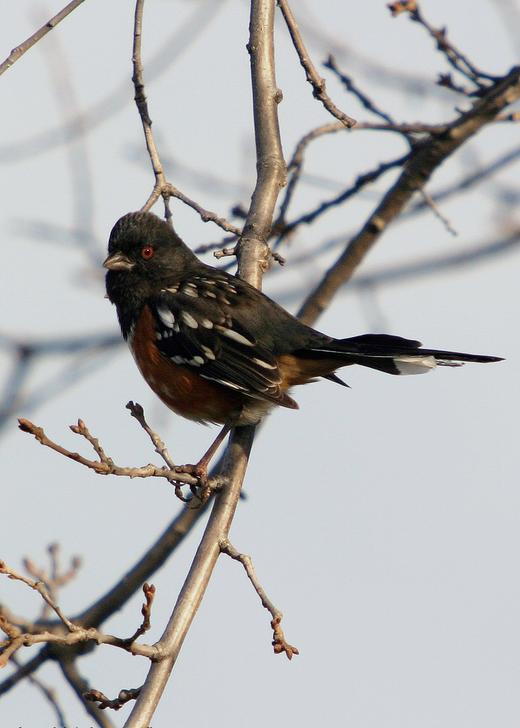
Rufous-sided Towhee The rufous-sided towhee is usually seen in oak tree and shrub vegetation near water. Its red sides, dark head and black and white underbelly identify this bird. It has a strong bill for crushing seeds, but it will also eat insects and berries.
The mourning dove, recognized by its plump, brown body and wedge shaped tail, needs daily drinking water in order to survive. It arrives in red Rock during the spring months and constructs flimsy nests on shrubs or the branches of the cholla cactus within one mile of water. These nests often fall apart during high winds or stormy weather, killing the young. However, the high reproductive rate of these birds allows a few nests to be lost without much harm to the overall productivity of the breeding pair. The parents feed their young a white liquid produced in their crop; the liquid is so rich in protein that young can fly in 10 days. Some young doves have left the nest within one month. The parents will then begin a new nest. Adult morning doves may raise up to six separate groups of young per breeding season in this manner. Watch for this bird as it flies to and from water sources throughout Red Rock Canyon.
The white-throated swift is a small bird with long narrow, stiff wings and a short tail. It can be distinguished from other swifts by the contrasting black and white pattern on its underside. Its small size and pointed wings grant it great speed and maneuverability that aid in the capture of insects. Swifts are frequently seen flying in steep canyons and over pools of water throughout the area.

Gambel's Quail Both chukar and Gambel's quail need a supply of water to supplement the moisture they derive from the seeds they eat. Although in the same family, they prefer different habitats within the conservation area. The Gambel's quail occurs in the desert thickets near washes, while the chukar prefers steep, rocky slopes where grasses are plentiful. Both rely on their feet for travel, but will make sustained flights in times of danger.
Many more bird species inhabit the Red Rock Canyon. Click here for a full list.
- Mammals
-
Red Rock Canyon National Conservation Area may seem rugged and desolate at first glance, but a closer look reveals an area teeming with wildlife. The desert often brings to mind snakes and lizards, but mammals too, inhabit these lands. In fact, more than 45 species of mammals occur in the Red Rock Canyon. The presence of cool temperatures, perennial water and a variety of plant species in the sandstone canyons provide escape from desert heat and aridity, making the conservation area a suitable habitat for wildlife.
Desert mammals can be divided into broad categories: carnivores (meat eaters), small and large herbivores (plant eaters), and insectivores (insect eaters). All must conform to specific behavioral traits to survive in such arid lands. Most desert mammals are nocturnal, which means active during the night. Besides being nocturnal, many adopt other water-saving habits as well.
Carnivores
Carnivores are predators and chiefly eat meat, although some will consume plants. They will drink water when it is available, but are not dependent on it since the moisture-rich flesh of their prey satisfies their water needs. This group includes such well known members as the coyote, kit fox, gray fox, bobcat and mountain lion.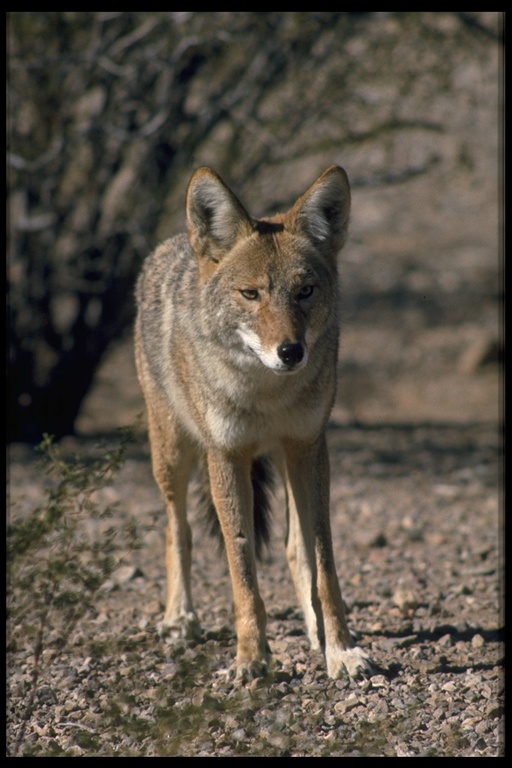
Coyote A member of the dog family, the coyote resembles its domestic cousins except that its nose is more pointed and its tail is bushier. The coyote is a very vocal mammal, communicating through barks and howls. Its scientific name, Canis latrans, literally means 'barking dog." In addition to being a predator, the coyote is an omnivore (plant and animal eater) and a scavenger. This varied diet allows the coyote to exist under the desert's harsh conditions and is one reason why the coyote is now the most widespread mammal in the United States. It can be seen occasionally from the 13-Mile Scenic Drive.
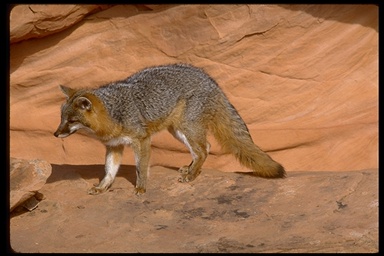
Gray Fox The gray fox also has a varied diet, but not to the extent of the coyote. It hunts widely at night, subsisting on rodents, ground squirrels, birds, wild fruit, insects, amphibians and small reptiles. It is an adept climber and will often search for food or escape danger by climbing trees.
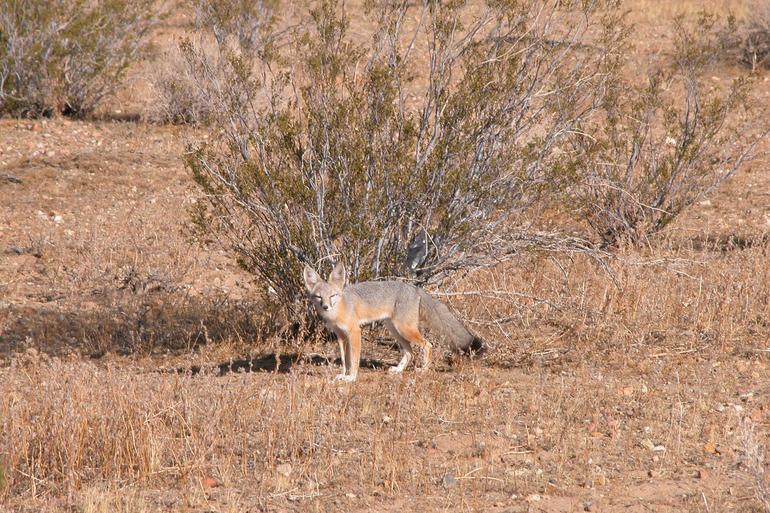
Kit Fox Weighing only five pounds, the kit fox is the smallest dog in the United States. It survives by being nocturnal and sleeping in the shade of a tree or in its den during the hot part of the day. Its large ears and sharp sense of smell help it to catch prey. Usually the kit fox seeks kangaroo rats, but lizards, insects, birds and rabbits will also be eaten. Watch for this elusive creature alongside the road as you drive through the desert at night.
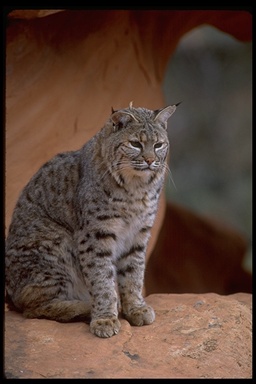
Bobcat The bobcat, the most abundant cat in the southwestern United States, also resides in the area. It spends most of the day under bushes, usually in rock fractures or canyons. The bobcat has little endurance and stalks prey rather than chasing it. It primarily eats rodents, but will take rabbits, ground-nesting birds, and occasionally, a young deer. Because of its nocturnal nature, it is not often seen unless disturbed from its daytime resting place.
Small Herbivores
This group includes the rodents, rabbits and hares. As herbivores, they primarily eat plants, although some will supplement their diet with insects and dead or decaying flesh. They rely on their diet to satisfy both their food and water needs. Some small herbivores found in Red Rock Canyon are the antelope ground squirrel, kangaroo rat, pack rat, blacktail jack rabbit and desert cottontail. Although most mammals in this group are nocturnal, the antelope ground squirrel is undaunted by the desert sun. This rodent is often seen from the 13-Mile Scenic Drive during the hottest parts of the day, with its white tail held close over its back as it runs about. To cool off, it may go below ground but usually flattens its body against the soil in a shaded area and loses heat through conduction. Although it can drop its body temperature by as much as seven degrees in this manner, it can lose 13 percent of its body moisture per day. To make up for this water loss, it feeds on green leaves and drinks early morning dew.
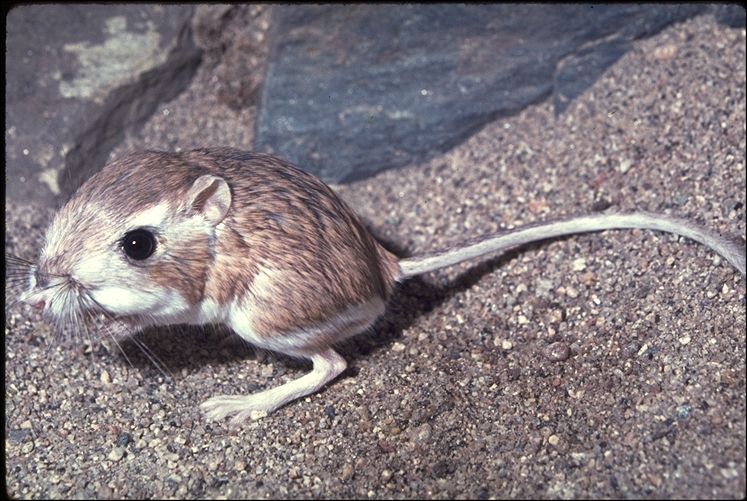
Kangaroo Rat The kangaroo rat, named for its habit of hopping rather than running, does not drink, use dew or eat succulent foods. Its only source of moisture comes from metabolic water, water produced through the digestion of food. However, digestion creates very little water, so the kangaroo rat must conserve every drop. Its nasal passages are much cooler than its internal body temperature. Air which passes through these nasal passages cools and water condenses on the mucous membranes, where it is absorbed. The kidneys of the kangaroo rat are also very efficient, producing a urine four to five times as concentrated as human's. Additionally, the kangaroo rat has adapted behavior to survive in the desert. It spends the hot days underground where the temperature is 30 °F (17 °C) cooler and the humidity is much higher. Seeds are stored in the burrow where they absorb additional moisture before being eaten.
Unlike rodents, rabbits and hares have two pair of upper incisors, one right behind the other. Thus, they are not classified as rodents, but as Lagamorpha, literally "animals of rabbit-like form." Rabbits differ from hare in that their young are born naked and blind, while young hares are born furred and sighted. The blacktail jack rabbit, contrary to its name, is a hare. To escape the heat it sits in "forms" during the day. Forms are shallow depressions near the base of plants where soil and air temperatures are cooler. Its enormous ears also provide a surface over which heat loss can occur.

Desert Cottontail The desert cottontail, a true rabbit, prefers brushier areas than the jack rabbit, such as rocky canyons, floors of dry washes and river beds; mesquite and catclaw thickets are preferred. Unlike jack rabbits, it retreats into burrows to escape heat and danger. Both cottontails and jack rabbits are very prolific. However, their numbers are kept low by predation and disease. Watch for these two mammals throughout the 13-Mile Scenic Drive.
Large Herbivores
Mule deer and desert bighorn sheep can also be found within Red Rock Canyon. Large herbivores derive some moisture from their plant food but unlike the small herbivores, also need drinking water periodically. The mule deer prefers foothills with low scrub growth or thick growth along washes. By late evening, it leaves its daytime hiding place to find water in seeps and springs.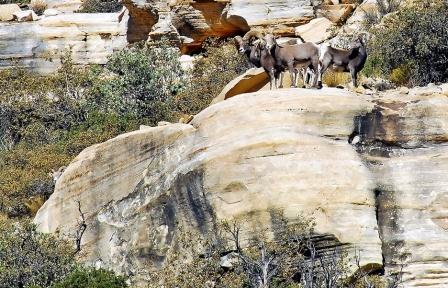
Desert Bighorn Sheep The desert bighorn sheep prefers steep, rocky terrain which provides escape from enemies and shelter from the weather. There are more than 13,000 acres of such habitat inRed Rock Canyon. The bighorn survives in the desert by traveling to water. It will not live more than two miles from a permanent water source. It may expand its range after rains fill more potholes, or tinajas, but such expansions are only temporary. The horns of the bighorn are formed by a bony structure at the base of the skull and are made of material called keratin. It takes about ten years for a ram horn to reach full size and they are often worn by butting and rubbing. Watch for these magnificent mammals on rocky cliffs throughout the area.
Insectivores
This group includes bats and shrews and primarily consumes insects. Bats are separated from all other mammals by possessing the power of true flight. To escape the heat and avoid competition with birds, they are active only at night. Seldom using their vision, they rely on echo location to find prey and avoid obstacles. To echo locate, the bat emits a series of chirps and clicks from its throat. These sounds reflect off nearby objects, informing the bat of moving insects or stationary obstacles. The odd facial structures of many species aid in the reception of the reflected sound. Although the majority of bats eat insects, a few feed on the nectar of flowers. These bats have long tongues with hair or bristles on the tip to allow them to reach in to gather nectar. Thus, bats serve not only to control disease-carrying insects, but act as pollinators as well.Shrews are very small mammals which spend most of their lives underground. They have reduced eyes and rely on their sense of smell and touch to locate insects. A voracious eater, the shrew is also a ferocious hunter, for to be without food for more than six or seven hours means certain death. Being an underground dweller, they are rarely seen.
Many more mammals live in Red Rock Canyon. Each has it own interesting adaptations for desert survival. Take the time to observe and learn about the mammals and other life forms in the area. Only through close observation can the desert and its associated plant and animal life be truly appreciated.
- Reptiles
-
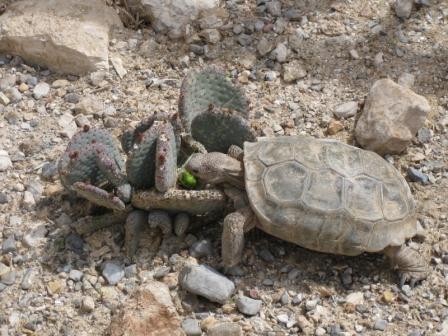
Desert Tortoise eating a cactus The desert tortoise (Gopherus agassizii) is a gentle reptile which spends much of its life in underground burrows. The burrows are excavated by the animals to escape the harsh summer and winter weather conditions of the desert.
The animal historically occupied a range that included the desert in southeastern California, southern Nevada, western and southern Arizona, southwestern Utah, and Sonora and northern Sinaloa, Mexico. Today, the creature's populations are largely fragmented, although it can be found in declining numbers in most parts of its former range.
Tortoise emerge from their burrows in late winter or early spring and in the autumn to feed and mate.
The reptile can be active during the summer if temperatures are moderate. The desert tortoise is the largest reptile in the southwest. Unlike other reptiles which are often feared by man, the desert tortoise is an appealing creature which has become a popular pet, perhaps to its detriment. One reason for its appeal is that the animal is not a threat, but rather a vegetarian, eating a wide variety of herbaceous vegetation. One of its treats is the flower of annual plants.
Tortoise emerge from their burrows in late winter or early spring and in the autumn to feed and mate.
The reptile can be active during the summer if temperatures are moderate. The desert tortoise is the largest reptile in the southwest. Unlike other reptiles which are often feared by man, the desert tortoise is an appealing creature which has become a popular pet, perhaps to its detriment. One reason for its appeal is that the animal is not a threat, but rather a vegetarian, eating a wide variety of herbaceous vegetation. One of its treats is the flower of annual plants.
Unfortunately, the slow moving reptile is vulnerable to a number of threats which could led to the demise of the species. These concerns lead to a petition to the U.S. Fish and Wildlife Service in 1984 to consider listing the desert tortoise under the Federal Endangered Species Act. After further evaluation and public hearings, the tortoise was permanently listed as threatened on April 2, 1990.
Major problems which appear to affect the tortoise in all or part of its range include:
- Loss or degradation of habitat because of off-road vehicles, military desert training maneuvers, various kinds of mineral extraction activities, grazing by cattle and sheep, and agricultural-residential development.
- Taking of individuals for pets and other forms of collection. Also, some animals have been killed outright or their shells mutilated in acts of vandalism.
- Excessive predation of juveniles by other species such as coyotes, foxes and ravens.
- Fragmentation of populations because of urbanization, highways and various rights-of-way associated with electric transmission lines, pipelines, etc.
- A respiratory disease has been found in some tortoise populations, and it is suspected the disease may have been introduced by infected tortoise pets whose owners have returned them to the wild.
What protection comes with a listing?
Under the provisions of the Endangered Species Act, the desert tortoise population is protected from "taking," which includes harming, killing or harassing desert tortoise or removing them from the wild. Violations are punishable by a fine and jail term. The law requires Federal agencies to consult with the Fish and Wildlife Service if a proposed project they plan to authorize, fund or carry out may affect the species. The Section 7 consultation process evaluates the impacts of the proposed action and determines whether the proposed action might jeopardize the continued existence of the species.
The Endangered Species Act -- Section 10(a)(1)(A) -- permits taking of tortoises for research. It is under this provision that the tortoises in The Desert Tortoise Conservation Center have been obtained. The tortoises in this center have been brought to this location under a joint research permit held by the Bureau of Land Management, the Nevada Department of Wildlife and The Nature Conservancy.
- Prehistoric cultural resources
-
Modern-day visitors are drawn to the Red Rock Canyon National Conservation Area for the recreational change of pace and beautiful scenery it has to offer. But, the area has been utilized to meet human needs for thousand of years. It is an area rich in cultural resources. Cultural resources are anything that man has used, made or altered. These resources tell a story of prehistoric Americans in a desert land. Over the thousands of years of human activity, in southern Nevada, as many as six different Native American cultures may have used the Red Rock Canyon.
The key to the area's prehistory is water. In the desert areas surrounding Red Rock Canyon and the Spring Mountains water is scarce. However, Red Rock Canyon contains more than 40 springs, as well as many natural catchment basins (known as tanks or tinajas). With the presence of dependable water, plant and animal life is richer and more concentrated than in the surrounding desert. The abundance of plant and animal food sources made Red Rock Canyon very attractive to hunters and gatherers such as the historical Southern Paiute and the much older Archaic, or Desert Culture Native Americans. These cultures traveled in small mobile groups that ranged over large areas of land following the ripening of various plant foods. Red Rock Canyon was an important stop on their seasonal rounds.
Even the more settled agricultural groups such as the Patayan Culture, from the banks of the upper and lower Colorado River near Hoover Dam, and the Ancient Puebloans either traded or traveled to Red Rock Canyon for its resources. Red Rock Canyon is considerably higher in elevation than the river valley homelands of these two groups. Because of the increased elevation, Red Rock Canyon has several higher altitude plant and animal types that would have been unavailable at the lower elevations.
For the most part, all of our knowledge of ancient Native Americans comes from the cultural resources they left behind. For example, we know that the Ancient Puebloans either visited the Red Rock Canyon or traded with its residents because we have found pieces of broken pottery that can be identified as their type of ceramics. Some pieces of pottery not only tell us who was in the area, but when they, were there. Pottery decoration styles, clay color and manufacturing techniques change with periods of time and vary from group to group. Even projectile points (arrowheads) can serve as time markers to archaeologists familiar with the prehistory of the area. Since these resources are our only source of information on American's prehistory, it is important to, preserve and protect them in their original location.
Cultural resources are more than storehouses of information. They can also be part of a very important and personal experience of Red Rock Canyon. Seeing a projectile point where it was dropped or shot hundreds or even thousands of years ago can provide the basis for a meaningful experience linking you with a person who walked or hunted here long ago. If you choose to remove the point from its place, not only have you broken the law and caused the loss of potential scientific knowledge, you have denied others a similar experience. Any artifact loses almost all of its value when it is removed from its original location.
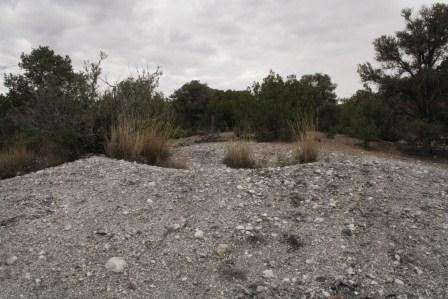 Roasting Pits
Roasting Pits
Roasting pits are perhaps the most common cultural resource found in Red Rock Canyon. Roasting pits are circular areas of fire-cracked and whitened limestone. They can vary in size from ground level circles five to six feet in diameter, to huge piles several yards high with large sloping sides. Roasting pits were used to roast various foods such as agave hearts, desert tortoise and possibly other plant and animal foods. The limestone was gathered, heated by the fire and then used to cook the foods. After prolonged heating, the limestone was raked aside and replaced with new rocks. This process caused the circular ring of rocks to grow with use. There are several roasting pits at the Willow Spring picnic area, including one of the largest in southern Nevada. The large pit is located at the base of the sandstone cliffs just behind and downhill from the restrooms. Rock Art
Rock Art
Rock art comes in two varieties, petroglyphs and pictographs. The difference between the two types is the manner in which they were made. Petroglyphs were pecked into the surface of the rock. Pictographs were painted on the rock. In Red Rock Canyon, a coating of dark "desert varnish" on lighter sandstone provides the perfect medium for petroglyphs, which are the most common of the two types of rock art found at Red Rock Canyon. If you want to discover some petroglyphs firsthand, the Red Spring area has a wide variety of different styles on the cliff face's and fallen boulders.Rock art is both enduring and fragile. It has lasted hundreds of years, yet many panels have been recently defaced by graffiti. Climbing on panels can also damage the art, as can attempts to embellish the petroglyphs for photographic purposes. These practices, are destructive and should not be done.
Other Cultural Resources
In the places where Native Americans camped and lived, they left behind the tools and trash of everyday living. Broken pots and stone tools are pieces of the puzzle that, when put together, tell the story of ancient ways of life and human adaptation to the desert. If you see these cultural resources, enjoy them, but please leave them to tell their story and to be appreciated by others.The Cultural Chronology of Southern Nevada
Southern Paiute 900 A.D. to modern times Patayan Culture 900 A.D. to early historic times in the 1800s Ancient Puebloans 1 A.D. to 1150 A.D. Pinto/Gypsum (Archaic) 3,500 B.C. to 1 A.D. The above dates are approximate and subject to considerable debate. Some are likely to be modified as our understanding of this region's prehistory increases. These dates are based on a number of techniques and methods including references in early historic writings, radiocarbon dates, ceramic (pottery) cross dating and comparisons with surrounding areas that have more established chronologies. Two other groups were present in southern Nevada and probably utilized Red Rock Canyon, although no evidence of their presence has yet been found.
San Dieguito 7,000 to 5,500 B.C. Paleo-Indians (Tule Springs) 11,000 to 8,000 B.C. - Historic cultural resources
-
Historic resources belong to recorded history. This period generally began with the arrival of western civilization in the early 1800s and continues through the present day.
It is illegal to disturb historic sites or collect artifacts. Each artifact found at a site tells an important story, allowing archaeologists to discover the activities that took place there. Please help us preserve and protect these sites for future generations.
The remains of early ranches, homesteads, and mining and construction camps are well preserved by the dry environment. Federal laws protect all cultural resources over 50 years old on public lands. This includes buildings and structures as well as trash scatters containing bottles and cans.
Red Rock was visited by the Spanish in 1776, bringing with them cultural changes, and from 1829-30 Antonio Armijo led the first successful round trip trade caravan from Santa Fe to the Pueblo De Los Angeles. Armijo and his scouts mapped the trade route, which became the Old Spanish Trail. Old Spanish Trail kiosks are located at the State Route 159 Overlook and Late Night parking lot along State Route 160.
In 1844 and 1845, Fremont retraced the path of the Old Spanish Trail in 1844 and 1845 by following the accounts of earlier explorers. Maps of Fremont’s route were distributed in the east and the route became a popular alternative for travelers wishing to avoid the Sierra Nevada during winter or those headed to southern California. Traffic increased after gold was discovered in California in 1848. The route eventually became known as the Mormon Road due to the number of Mormon settlers traveling from Salt Lake City, Utah to San Bernardino, California.
As the early settlers passed through the area, they also discovered the canyon and finally homesteaded in this meadow. The items remaining from the early settler’s use of this area are part of the cultural resources you see today. Settlers, initially few in number, used transportation routes and homesteaded in this area over the years. They brought with them non-native plants and domesticated animals into these areas.
Horace and Glenna Wilson, early homesteaders diverted water from Pine Creek for a large garden. They grew sweet potatoes, beans, melons, strawberries, blackberries, grapes, and peaches – all non-native plants.By the early 1900s, sandstone was quarried in what is now Sandstone Quarry. During the 1930s the Civilian Conservation Corp was active building wildlife guzzlers in Red Rock. The evidence of modern cultural history can be found in the ruins of buildings and quarrying sites at Red Spring, Sandstone Quarry, La Madre Spring and Pine Creek.
- Geology
-
Ocean
For much of the past 600 million years, the land that is now Red Rock Canyon National Conservation Area was the bottom of a deep ocean basin and the western coast of North America was in present day western Utah. A rich variety of marine life flourished in those waters and left behind deposits of shells and skeletons more that 9,000 feet thick which were eventually compressed into limestone and similar carbonate rocks.Swamps
Beginning approximately 225 million years ago, crustal movements caused the sea bed to slowly rise. Streams entering the shallower waters deposited mud and sand which later consolidated into shale and marine sandstones. Changing land and sea levels trapped large bodies of water which later evaporated leaving behind layers of salt and gypsum in some areas. Exposure of the sediments to the atmosphere allowed some of the minerals to oxidize, resulting in red and orange colored rocks. Streams meandering across the broad plain deposited sand, mud, gravel and other debris such as logs. In some cases, minerals in the groundwater replaced the organic materials in the buried logs forming petrified wood. Petrified wood is one of the few fossil remains found in the rocks at the foot of the cliffs.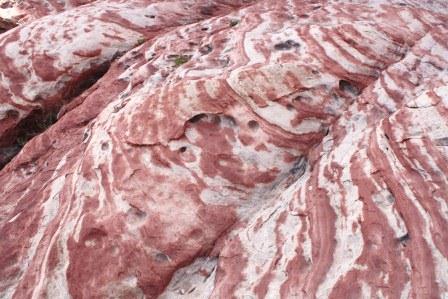 Deserts
Deserts
About 180 million years ago the area was completely arid, much as the Sahara Desert is today. A giant dune field stretched from this area eastward into Colorado, and windblown sand piled more than half-a-mile deep in some spots. As the wind shifted the sands back and forth, old dunes were leveled and new ones built up leaving a record of curving, angled lines in the sand known as "crossbeds." These shifting sands were buried by other sediments, and eventually cemented into sandstone by iron oxide with some calcium carbonate. This formation, known locally as the Aztec Sandstone, is quite hard and forms the prominent cliffs of the Red Rock escarpment. In some areas the iron minerals in the rocks have been altered and concentrated giving the rock it's red color. Thrust Faulting
Thrust Faulting
The most significant geologic feature of Red Rock Canyon is the Keystone Thrust Fault. The Keystone Thrust is part of a large system of thrust faults that extends north, into Canada and began to develop approximately 65 million years ago. A thrust fault is a fracture in the earth's crust that is the result of compressional forces that drive one crustal plate over the top of another. This results in the oldest rocks on the bottom of the upper plate resting directly above the youngest rocks of the lower plate. At Red Rock Canyon, the gray carbonate rocks of the ancient ocean have been thrust over the tan and red sandstone in one of the most dramatic and easily identified thrust faults to be found. The Keystone Thrust Fault extends from the Cottonwood Fault along State Route 160 north for 13 miles along the crest of the Red Rock escarpment. It then curves east along the base of La Madre Mountain before it is obscured by very complex faulting north of the Calico Hills. - Fossils
-
Paleontologists have confirmed fossilized tracks (footprints) made 180 to 190 million years ago in sandstone within Red Rock Canyon National Conservation Area. This is the first documented dinosaur tracksite in Nevada.
Dubbed the Red Rock Tracksite, dozens of tracks from the Early Jurassic period have currently been documented.
At this point, two types of tracks and trackways are recognized from the site:
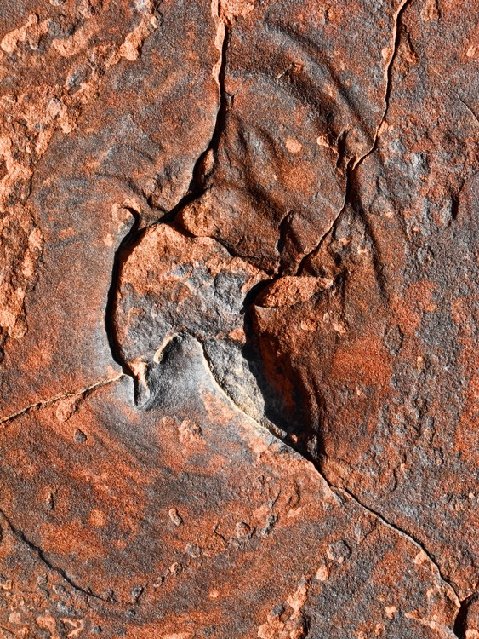 Grallator tracks are footprints made by small theropod dinosaurs (two-legged, three-toed, meat-eating dinosaurs)
Grallator tracks are footprints made by small theropod dinosaurs (two-legged, three-toed, meat-eating dinosaurs)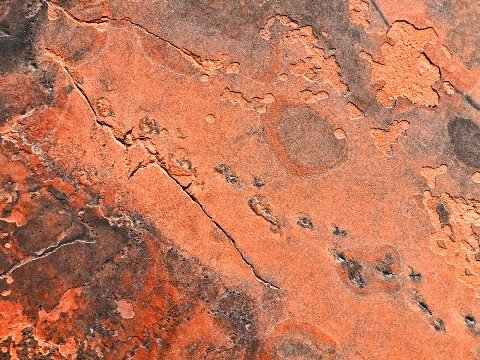 Octopodichnus tracks are footprints made by arthropods (possibly similar to modern spiders and scorpions)
Octopodichnus tracks are footprints made by arthropods (possibly similar to modern spiders and scorpions) - Wilderness
-
Popular activities in Red Rock Canyon National Conservation Area’s La Madre Mountain Wilderness and Rainbow Mountain Wilderness include hiking, rock climbing, canyoneering, horseback riding, wildlife watching and photography.
La Madre Mountain Wilderness is 47,180 acres of eye-catching canyons, rugged gray carbonate ridges and mountain peaks. This area is also home to the Keystone Thrust formation, an internationally recognized formation where older limestone has been pushed over younger sandstone.
Rainbow Mountain Wilderness is 24,997 acres and is an artist’s dream with gorgeous vertical red and buff sandstone in some places and deep narrow canyons that twist and turn, carpeted with vegetation. The high points of this wilderness are Mount Wilson at 7,070 feet and Rainbow Mountain at 6,924 feet.
Designated by Congress in 2002, these wilderness areas offer outstanding opportunities for solitude and exemplify the timeless beauty of America’s natural wonders. In order to provide these opportunities, wilderness is to remain free of permanent structures, motor vehicles, motorized equipment and most forms of mechanical transport.
